The Big Interview
UCCA Director Philip Tinari on Why He Wanted to Bring the First Major Picasso Show to China, Now
To tell the story of Picasso in China is to tell the story of China itself, Tinari argues.
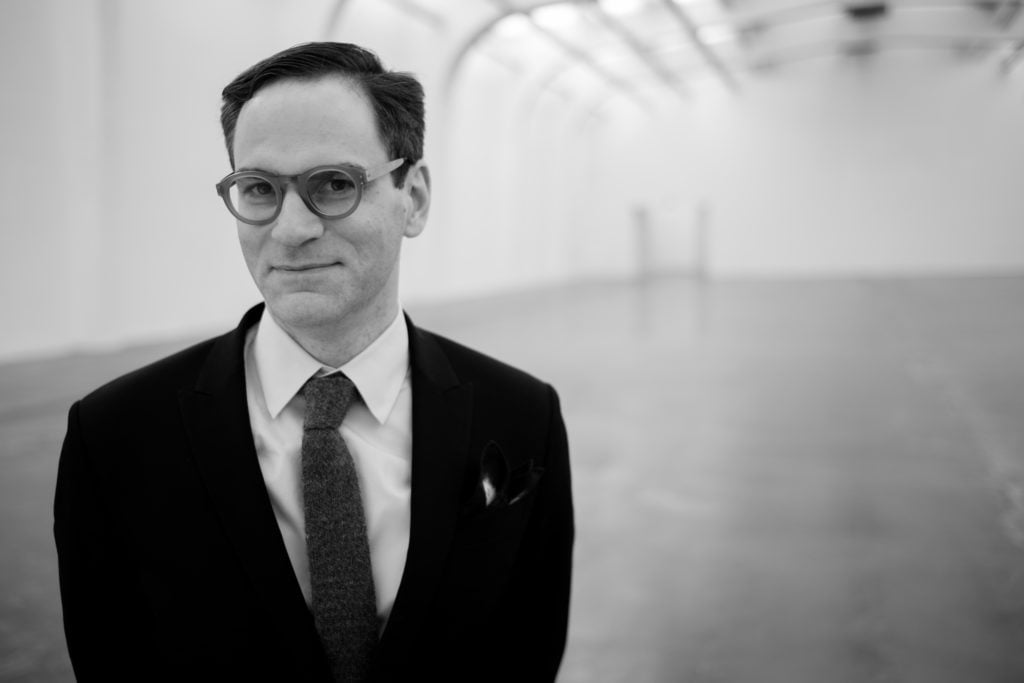
To tell the story of Picasso in China is to tell the story of China itself, Tinari argues.

Andrew Goldstein

If this year’s escalating trade war between China and the United States is cause for pessimism about the outlook for East-West relations, some hope can be found in the fact that steadily growing avenues of cultural interchange are continuing to knit our societies closer together, even if the pace can seem glacially slow. Case in point: this summer, the first major museum survey of Pablo Picasso to come to China has been taking place at Beijing’s UCCA Center for Contemporary Art.
The show—now entering its final week—has been a staggering success. Titled “Picasso – Birth of a Genius,” it has welcomed more than 288,500 visitors since opening in June, making it the most popular exhibition in UCCA’s 12-year history. It has also served to inaugurate a new chapter in Beijing’s museum culture. Organized in partnership with France’s Musée national Picasso-Paris, the state-owned museum that lent both the works and the curatorial services of its head of collections, Emilia Philippot, the show flexes the muscles of UCCA’s newly upgraded building, which was renovated earlier this year by Rem Koolhaas’s OMA firm into a world-class exhibition space.
All of this, both the show and the makeover, are owed to the vision of UCCA director Philip Tinari. Having led the institution through a period of turmoil following Swiss collectors Guy and Myriam Ullens’s decision to put the museum they founded up for sale in 2016, Tinari—the Philadelphia-born former editor of Leap magazine who is known for his exceptional Mandarin and deft politesse alike—is making a bold declaration about UCCA’s future ambition with the survey. It will be hard to follow, but he will have to.
To better understand the significance of presenting the biggest Picasso show in China’s history—the last one, timed to a visit by Franćois Mitterrand in 1983, was a mere quarter of the size—artnet News’s Andrew Goldstein spoke to Tinari about why he decided to do the show, what it means, and why it almost didn’t happen. This is the first part of a two-part interview.
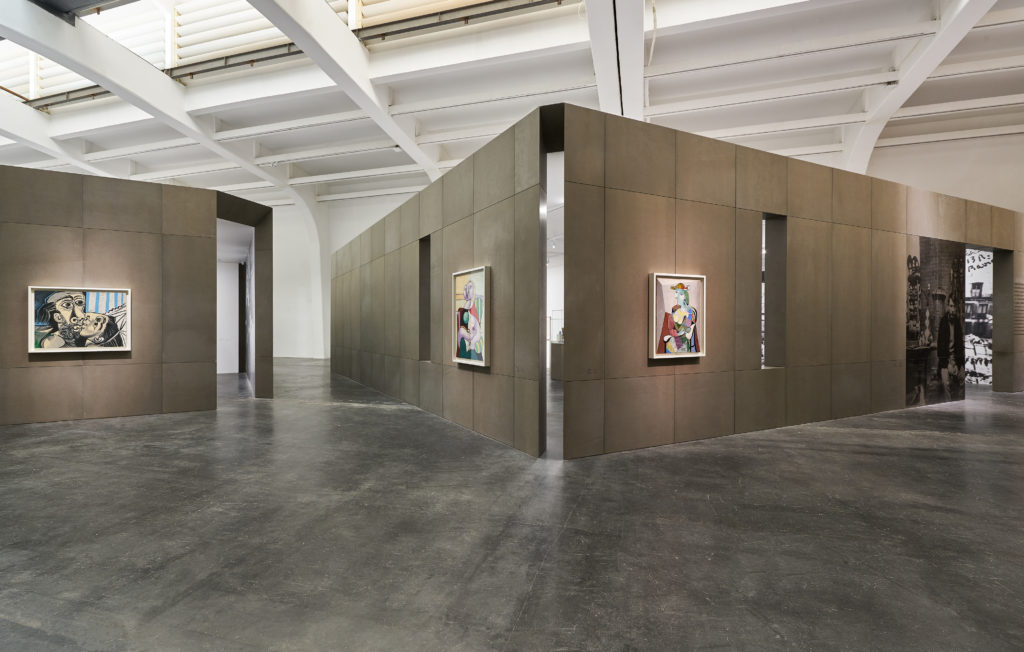
An installation view of the UCCA’s Picasso exhibition. Photo courtesy of the UCCA.
Why did you find it important to bring Picasso to China in the first major exhibition in the country?
There are very few figures art-historical figures who are household names in China, and he’s definitely one of them. So part of what drew me to the show is the historical project of presenting the work with integrity and a compelling narrative that’s educational and enlightening for people. Another part of it was to make a statement about who we are as an institution, and the growth that has happened over these last few years since our restructuring. It seemed like an emblematic project to announce a new era at UCCA, allowing us to unveil our internal development and upgrades and also to engage whole new kinds of audiences who previously didn’t really what UCCA was about.
So you saw the show as a way to reintroduce UCCA to people, and to declare what kind of institution it will be.
Yes, exactly. The renovation was building up to this show, in a way. In terms of leading this organization, I find it useful to have key milestones to aim for that help chart the course, and this was definitely one of those—it’s something very easy for the public and also for our stakeholders and colleagues to understand, since we hadn’t really been engaged in Modern art before. I had only done a small Duchamp show in 2013, called “Duchamp and/or/in China,” which basically revolved around the Boite-en-valise and other multiples, but that was it.
We had always been much more of a non-collecting institution of living artists, so to go in this direction is a big change. Whenever I talk to the Chinese media about the show, this is always the first question: “You guys are contemporary art, but this is Modern art.” The thing you have to realize, though, is that it’s not like there’s a surfeit of institutions doing great Modern programming in China. There just aren’t. Also, it’s interesting to be able to do a show of an artist like Picasso in a space like ours—a kind of cavernous post-industrial hall—as opposed to, say, the Musée d’Orsay or the Fondation Beyeler. It’s a very different kind of experience, and it brings something different to the work.
Well, they say that a classic is news that stays news.
It’s true. We have about 10 of the same pieces that were in the d’Orsay show and the Beyeler show, and then into our show, and Laurent Le Bon, the director of the Picasso Museum, was saying how if you put the work in the d’Orsay then Picasso looks like a 19th-century artist, but if you put him in a space like ours he starts to look very contemporary. In any case, this has been an amazing learning experience for us to see how well people have responded, and how excited they are about having a show like this brought to their doorstep.
Funny enough, the exhibition almost didn’t reach their doorstep. Why was it so difficult to get the show’s artworks through customs to enter China?
Well, the policy is that anytime you temporarily import works of art, you’re supposed to basically guarantee the tariffs [that you would have to pay were you to sell the work] by leaving enough money to cover the import taxes with customs for the duration that the work is in the country. For normal shows that’s not really an issue, because it’s based on insurance value and, in the end, shippers essentially have these financial products that cover this—they have money with customs constantly, so just pay the interest on that money for the period you need to guarantee. So for more straightforward shows with contemporary artists, it’s usually easy—but this was a whole other level in terms of valuation.
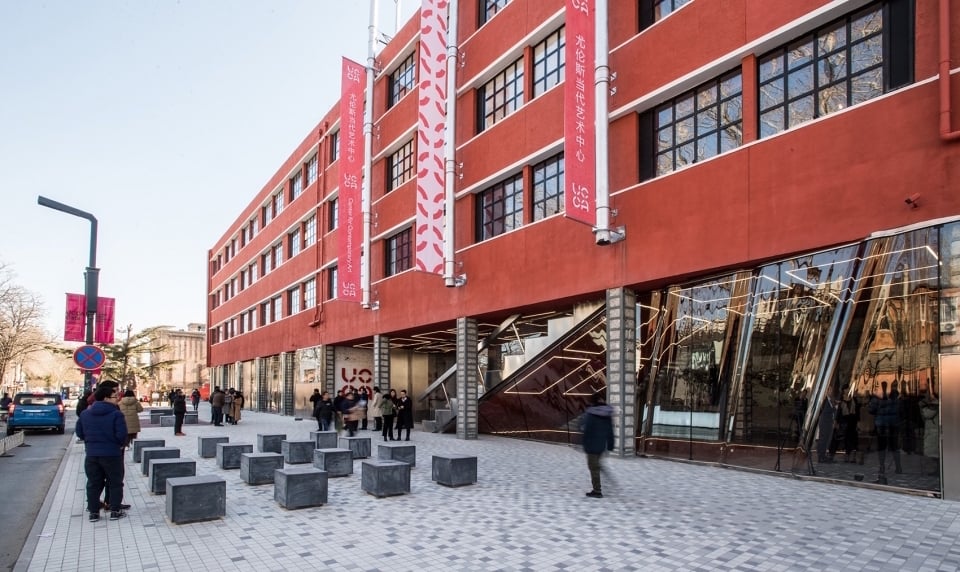
The new facade of UCCA Center for Contemporary Art in Beijing. Image courtesy of Office for Metropolitan Architecture, photo by Bian Jie.
How much did customs want you to guarantee?
They wanted €200 million for the deposit, and you can’t really borrow that amount of money—it’s just not a comprehensible figure for us. So we needed to get it waived, and fortunately the Chinese and the French state were able come to terms on this, basically because the French ambassador raised the issue in meetings with his Chinese counterparts. The complexity was that although the works belong to a state collection, we are not a state museum, even though we’re an accredited museum. So it just required people in the Chinese bureaucracy to go out on a bit of a limb, which they did.
So it’s not as if the Chinese state was trying to block the show—in fact, they had to take political action to make it possible.
Exactly.
So, in a Western context, it’s likely that your average person walking into a Picasso show will know a few things about him: that he was a genius who painted people’s noses in funny places, that his artworks have become incredibly expensive, that he was a domineering womanizer, and that he was a squat, bald man who wore a striped white-and-blue shirt. They would know these things just from being immersed in mainstream culture. What kind of familiarity with Picasso does your average Chinese museum-goer bring to the show?
There are a couple layers to that, going back to when Picasso was alive and news of his work was being transmitted to China via Chinese artists who were studying in Paris. We forget that oil painting in China only has 100-plus years of history, beginning when a generation of artists was going to Japan and Paris to study painting in the early 20th century, and the knowledge they gathered was being disseminated through a thriving culture of art publications, specifically in Shanghai at the time. News of Cubism was also reaching China, where it led to the same kinds of confused parodies that you had in America and even in France, where you would people joking, “What is this Cubism? It doesn’t make any sense!”
Picasso’s reputation in China changed after he joined the French Communist Party in 1944 and then painted a dove that became a kind of logo for an international peace summit in Paris in 1949. The People’s Republic of China very much sees itself as part of this post-World War II anti-fascist new world order, so whenever he painted one of these doves—and there were several editions—the People’s Daily always ran them on the front page. He was embraced as comrade Picasso, and the China government even sent a delegation to visit him and present him with a gift. That changed again during the Cultural Revolution, when he was critiqued as being too bourgeois, but then by 1983 he received his first exhibition in China, and he definitely loomed large for all the artists in the Stars and the groups of early contemporary artists in China.
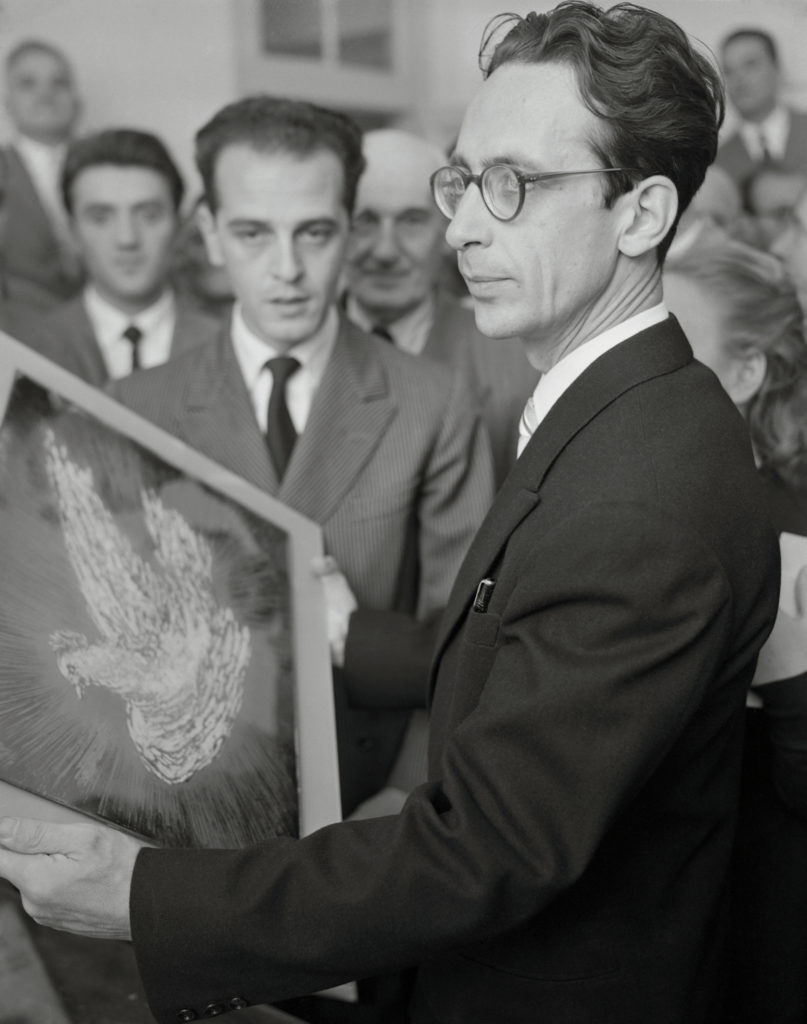
A panel with one of Picasso’s doves of peace as seen during a presentation of the Stalin Peace Prize in Rome’s Partisans of Peace Headquarters. (Courtesy of Getty Image/Bettmann/Contributor)
What specifically made his work fall out of favor during the Cultural Revolution?
Well, in the Cultural Revolution all foreign culture was off the table. But even before that there were some issues with him. At the time, all these Chinese artists were trying to square the circle of how to understand Picasso. They knew he was a member of the Communist party, but where in his work was there a basis for seeing him as truly a friend of the people? They came down to the one piece, The Frugal Repast, which you could read in this almost socialist-realist vein of depicting the suffering of the poor. But it was pretty hard for them to make this case compellingly, because very little of Picasso’s other work has socialist themes. None of it has socialist themes, really.
Even so, at least a few Chinese artists seemed to pick up the cubist style, as I was surprised to see in your show’s fascinating catalog. Was that a brief experimental moment, or did the seeds of cubism actually take root in China in a meaningful way?
I don’t think it was that meaningful. Fifteen years ago a Japanese scholar did a show called “Cubism in Asia” that looked at the parallel trajectories of cubism’s influence in Japan and Korea and China. But compared to Fluxus, which later on became first global art movement, the contexts were still too disparate. What you definitely had was Zhang Daqian, one of the key Chinese painters of the 20th century, Qi Baishi, another major figure in the Modern market, taking inspiration from Picasso on a very personal level, partly because of his actual work but more just in terms of his persona of the greatest living artist. They both saw themselves as Picasso of the East. There are some great pictures of Zhang Daqian, in his robes and his beard, going to visit Picasso in the South of France.
In the catalogue, you write that “Picasso’s evolution, like that of China itself, compares to ’crossing the river by feeling the stones’”—which was Deng Xiaoping’s famous metaphor for China’s development. Elsewhere in the catalogue, it says of Picasso that “among all Western artists, his trajectory in China hewed closest to the radical changes that the country underwent.” How so?
Well, it’s like I was saying—because he was so famous and so well documented in China across these different historical moments, you can tell a story about Picasso and China that actually ends up being a story about China in the 20th century, from the initial moment of openness in the ‘20s and ‘30s when people discovered him to the time of the Cultural Revolution when people forgot to the kind of re-engagement that happened after the country opened up again in a time of reform.
So it’s interesting and yet it’s also kind of axiomatic, in a way. We decided not to tell that story in the show, to instead let the art speak for itself and address these themes in the catalog and exhibition programming.
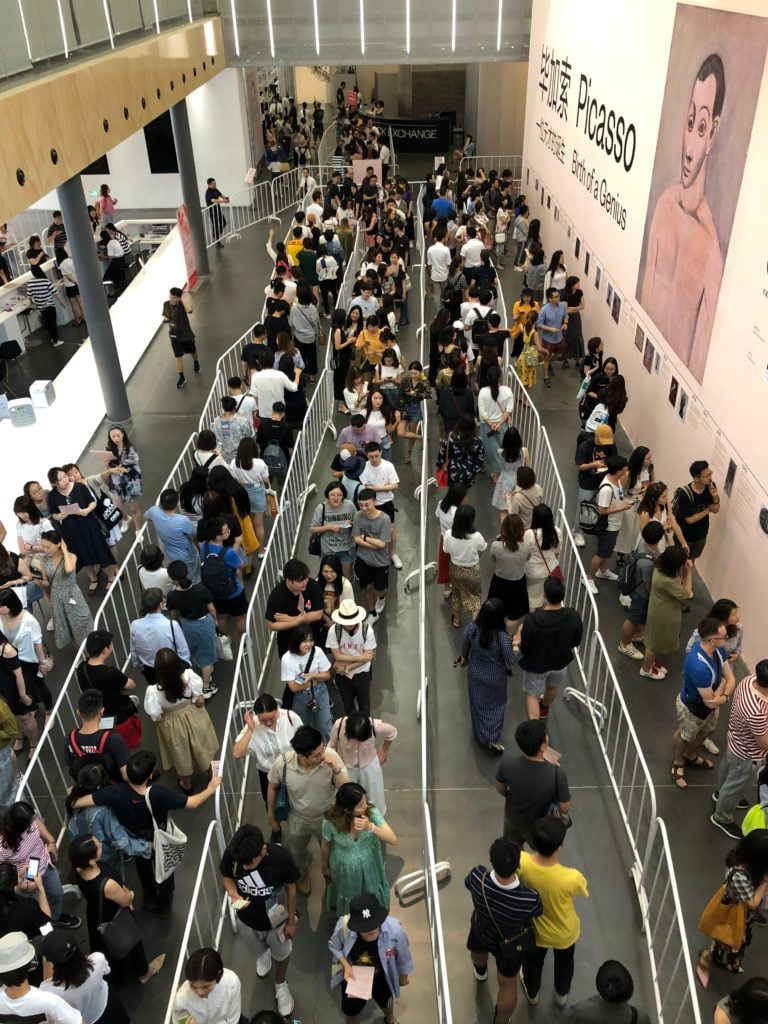
Crowds waiting in line for the UCCA’s Picasso survey. Courtesy UCCA.
You also wrote that this exhibition was “curated specifically for this context.” What does it mean to curate a Picasso show specifically for a Chinese audience?
For example, I’m not sure “Picasso: Birth of a Genius” is a title you would use in New York today. A lot of people, of course, have raised questions about what genius is and how genius is constructed and whether it contains biases of class, race, gender, and other things. At the same time, it’s been very useful to frame this show around how Picasso became Picasso, and what made him who he was, a figure constantly full of new great ideas. I think that has been really inspiring to our public, because there’s such a focus in the public discourse on innovation, creativity, and having new ideas as a way of maybe compensating for a shortage of these things in the past.
We actually made these little lapel pins that say “genius” in Chinese. It’s a funny word in Chinese, because it’s not quite as loaded—the literal translation would essentially be “one who has gifts from heaven,” who is naturally gifted. These pins have especially been popular with parents and kids, because the show starts with pieces from when Picasso is very young, only 12 or so. It’s a way of talking about human potential and achievement and these kinds of more educational themes that I think people really respond well to.
Of course, Picasso received stringent academic training when he was a kid—he could famously draw like Ingres when he was a young teenager—before taking a more avant-garde path.
Yes, and that whole idea that if you want to break the rules you have to master them first kind resonates, because the academic painting tradition is so very alive in China right now—you have huge art academies that still run on that kind of pedagogy—so to see someone coming to terms with it and then moving beyond it is inspiring. In fact, it may be relevant here in a way that it isn’t elsewhere anymore.
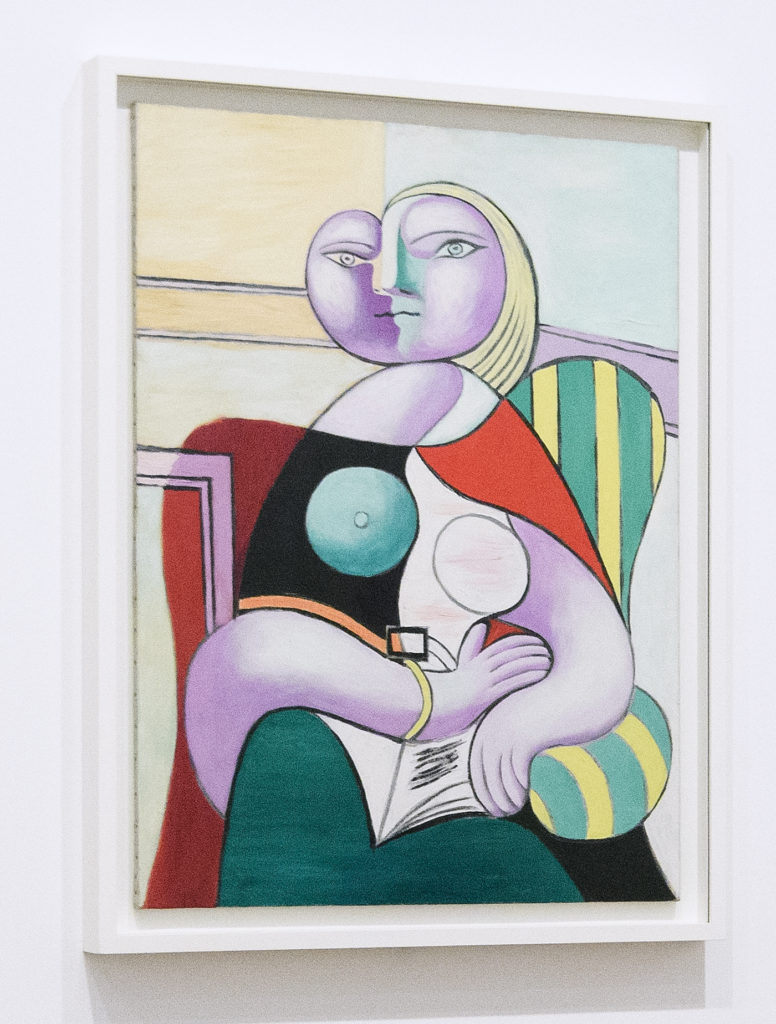
Pablo Picasso’s Reading, 1932. (Photo by Leon Neal/Getty Images)
Going back to the idea it was hard to find socialist themes in Picasso’s art, you could argue that the actual predominant theme in Picasso’s work, aside from artistic genius, is erotics. Despite that, it appears there’s only one slightly sexy Picasso in the show, Reading from 1932, which shows Marie-Therese Walter with a book suggestively open between her legs. Are there sensitivities in China around showing this more sexual side of Picasso, with his abundant nudes?
I think there is a version of that story that people know in China as well. There are a lot of questions about his romantic involvements, but this is where it’s good that the curator, Emilia Philippot, who is the head of collections at the Musée Picasso, knows the life and the work intimately. She’s fairly resolutely in the anti-biographical camp, however, so she tried to curate the show more around visual resonances and historical references and these kinds of things.
There are tons of pictures of him in the show. That’s always one funny reaction that international visitors have—it’s like they’ve never been in a show with this many pictures of the artist—but that was an exhibition-design decision as much as anything else. Each section is a collection of work that kind of covers a period, so the second section is about his early mature style and first years in Paris, starting with his Blue Period Self-Portrait, which is probably one of the most famous pieces in the show, and ending with a bit about the summer of 1906 that he spent in Gosol, a town in the Pyrenees, that is the sequel to a whole other section about also Les Demoiselles d’Avignon and the beginning of Cubism. It evolves like that, so even for Picasso aficionados I think it would be an interesting show to explore. And the exhibition design is really wonderful—to be in this big cavernous nave and then to have these five rooms with sight lines and adjacencies and windows that create new sight lines and adjacencies is a special thing.
I saw the show includes one of Picasso’s portraits of his friend Casagemas, whose suicide after being spurned by a woman prompted the Blue Period. When I saw the Picasso show at the Beyeler in June, I noticed an extraordinary Casagemas painting I had never seen before, an incredibly profane version of the Assumption where his friend is seen to rise from his grave and ascend to heaven, only instead of finding angels awaiting him he is surrounded by beckoning naked women. Would that kind of painting be hard to show in China? Did the sexual content of the exhibition have to be toned down?
All I can say is our checklist of artworks was prepared by the curator in line with her concept and vision, and it came through totally unscathed. Granted, in the d’Orsay show there is a whole section of really erotic work, which is not in this show. It’s hard to speculate here, because we didn’t have any issues, but, then again, that’s not to say that every single piece would have been fine.
The second half of this interview, to be published tomorrow, will delve into the extraordinary opportunities for art that the success of “Picasso – Birth of a Genius” makes possible.